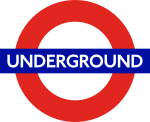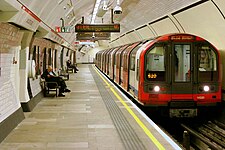London Underground
 |
|

|
|
| Overview | |
|---|---|
| Locale | Greater London, Buckinghamshire, Essex, Hertfordshire |
| Transit type | Rapid transit |
| Number of lines | 11 |
| Number of stations | 270 served (260 owned) |
| Daily ridership | 4.8 million |
| Annual ridership | 1.34 billion (2015/16) |
| Website | London Underground |
| Operation | |
| Began operation | 10 January 1863 |
| Operator(s) | London Underground Limited |
| Reporting marks | LT (National Rail) |
| Technical | |
| System length | 402 km (250 mi) |
| Track gauge | 1,435 mm (4 ft 8 1⁄2 in) standard gauge |
| Electrification | 630 V DC fourth rail |
| Average speed | 33 km/h (21 mph) |
The London Underground (also known simply as the Underground, or by its nickname the Tube) is a public rapid transit system serving Greater London and some parts of the adjacent counties of Buckinghamshire, Essex and Hertfordshire in the United Kingdom.
The world's first underground railway, the Metropolitan Railway, which opened in 1863, is now part of the Circle, Hammersmith & City and Metropolitan lines; the first line to operate underground electric traction trains, the City & South London Railway in 1890, is now part of the Northern line. The network has expanded to 11 lines, and in 2015–16 carried 1.34 billion passengers, making it the world's 11th busiest metro system. The 11 lines collectively handle approximately 4.8 million passengers a day.
The system's first tunnels were built just below the surface, using the cut-and-cover method; later, smaller, roughly circular tunnels – which gave rise to its nickname, the Tube – were dug through at a deeper level. The system has 270 stations and 250 miles (400 km) of track. Despite its name, only 45% of the system is actually underground in tunnels, with much of the network in the outer environs of London being on the surface. In addition, the Underground does not cover most southern parts of Greater London, with less than 10% of the stations located south of the River Thames.
The early tube lines, originally owned by several private companies, were brought together under the "UndergrounD" brand in the early 20th century and eventually merged along with the sub-surface lines and bus services in 1933 to form London Transport under the control of the London Passenger Transport Board (LPTB). The current operator, London Underground Limited (LUL), is a wholly owned subsidiary of Transport for London (TfL), the statutory corporation responsible for the transport network in Greater London. As of 2015[update], 92% of operational expenditure is covered by passenger fares. The Travelcard ticket was introduced in 1983 and Oyster, a contactless ticketing system, in 2003. Contactless card payments were introduced in 2014.
...
Wikipedia
